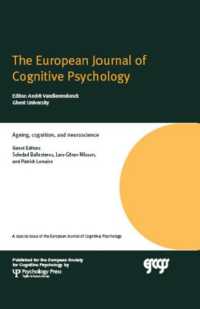- ホーム
- > 洋書
- > 英文書
- > Performing Arts
Full Description
In this inspirational new manual, Andy Hinds shares what he has learnt over thirty years of teaching the speaking and acting of Shakespeare's texts. In simple steps he brings the reader to a full understanding of how Shakespeare's language 'works', lucidly outlines a number of practical guidelines, and provides simple, test-proven exercises to put each guideline into practice.
Key points include:
Acting Solo Speeches | Pronunciation | Imagery and imagistic language | Acting Shakespeare's Verse | Acting Shakespeare's Prose | Breathing
The essential guide for all actors, students, teachers or directors tackling Shakespeare's plays or speeches and wishing to release the full dramatic power of his words.
Contents
Contents: SECTION ONE: THE FOUNDATION - FEEDING OFF THE ENVIRONMENT 1 - Introduction 2 - When you speak - 'ask', 'explain' or 'command'. 3 - Objectives - Understand the objective of speech or utterance - Act with practical purpose. 4 - Addressees - Open fresh line of communication each time the addressee changes. 5 - Outward Visual Connection - Eyes at all times outwardly and actively connected. 6 - Action Not Feeling - 'yin' and' yang' - achieving the balance. 7 - Realize, Discover, See the light. 8 - Being in the moment - Thinking on the line; the thought is the line; the line is the thought. 9 - Standing over one's utterances - 'Containing' the accumulated energy. 10 - Asides - different types of Asides and how to play them. 11 - Transitions - how to make transitions within a speech. SECTION TWO: WHAT THE VERSE, POETRY AND RHETORIC OFFERS YOU AND ASKS OF YOU 1 - The Iambic Pentameter - What is it? 2 - Making it sound 'natural' - How would you instinctively say it?... How honouring and working the verse makes it sound 'natural'. 3 - Finding the beats - 'Skidding over the beats'... 'Missing the beats'... 'Over emphasising the beats'. 4 - 'Reciting' - When 'honouring' the verse takes over from clear communication. 5 - Being in the active, creative present of the line. 6 - Don't 'sign off' - How not to throw away the energy one has built up during a speech or line. 7 - 'No subtext' - Committing to the surface meaning of the line. 8 - Imagery - Making the concrete surface of the image clear. 9 - Personifications - Speak to the 'personification' as if it is alive and human. 10 - Oppositions - Give appropriate pointing to the 'a's' and the 'b's'. 11 - Parentheses - Separating the 'spine of sentence' from the 'parentheses'. 12 - Adjectives and Adverbs - Making them 'necessary'. 13 - Caesurae - What is a 'caesura'? Identifying it, and using it to advantage. 14 - Rhetorical 'lists'. SECTION THREE: SOLILOQUIES AND 'BIG SPEECHES' All that has gone before will apply to soliloquies - usually more so. But there are specific considerations. 1 - 'Objectives' - Feeding off and talking to the imagined environment, the audience, the universe. 2 - 'Who am I talking to?' - Identifying and addressing oneself to the most useful of the possible addresses. 3 - 'Eyes' - Where do I Iook? 4 - 'Signing off' - Containing and not throwing away the energy at the end of the speech. 5 - 'Soliloquy as primarily a process of enlightment' - Identifying the different place the character has arrived at by the end. 6 - 'Transitions' - identifying and playing the transitions within the speech for to achieve clarity and the building of energy. 7 - 'Building' the speech.







